Dr Aprile Pazzo
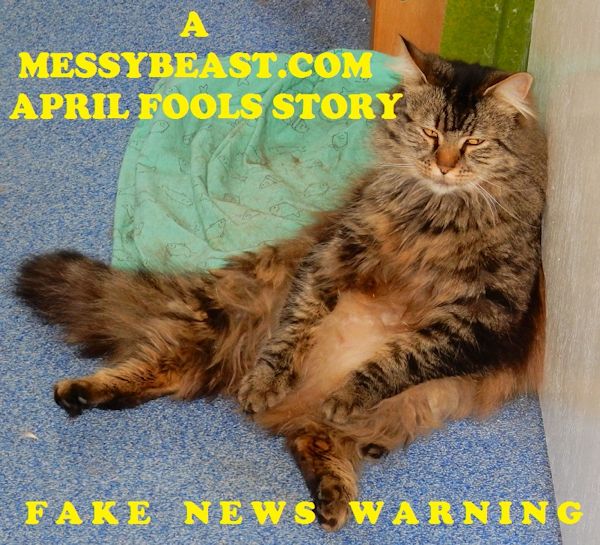
Publication date 01.04.2007
NANOPARD (DOMESTIC PANTHER)
Dr Aprile Pazzo 
Publication date 01.04.2007
Abstract
The Nanopard breed is derived from crosses between large domestic cats and the smallest subspecies of wild leopars, Panthera pardus nanopardus (Somali leopard). This paper outlines the breeding strategy used to achieve the desired result of a domestic feline with the appearance of a miniature leopard. Unlike the French Cat/Tiger Hybrids reported in 2003, no genetic modification was used.
Choice of Partners
| Cat max recorded length (excluding tail) | up to 30 inches (76 cm) has been recorded |
| Cat weight |
Up to 25 lbs (11.5 kg) (for non-obese specimens). |
| Nanopardus average length (excluding tail) |
45 inches (115cm) (male) |
| Nanopardus weight |
from 75 lbs (34 kg ) |
There was considerable size mismatch between the female Somali leopard and her domestic cat consort. However, successful hybrids have been made between a male ocelot and female puma cohabiting in a private collection; the ocelot being one third the size of his mate. Successful hybrids also occurred between a caracal and domestic cat where a stray domestic cat was a frequent invader of the caracal's enclosure. When breeding leopons in Japan, the lioness was observed to lie on her side to allow the much smaller leopard male to mate her. This demonstrates that hybrids are possible, in spite of a size difference, as long as the female is the larger partner.
Among domestic cat fanciers, it has been more usual to cross a wild species male to a domestic female, but in the case of the Nanopard this posed too much risk. Male cats grip the female by the neck during mating. Even among crossings of the smaller wild species with domestics, there have been cases where the larger wild male broke the domestic female's neck.
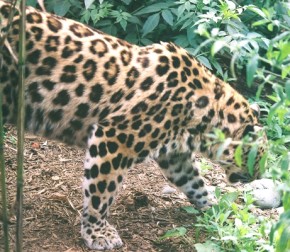
One of the leopard dams, showing the desired markings |
Although a short-coated cat was desirable, no short-coated male domestic cats of appropriate size were available to the breeding programme. Spotted breeds were ruled out to ensure the pattern was derived from the leopard. Breeds derived from existing hybrids were ruled out to avoid introducing other wild-type genes which would influence the pattern. The two largest breeds were considered. Of these, the Ragdoll carried the undesirable traits of colour-pointing and white spotting. A solid black Maine Coon type cat with no recessive colour dilution gene was selected.
Imprinting
Because leopards will kill and eat cats, the parents must be raised together and imprinted on each other. Two female cubs were fostered on to a domestic female (with supplementary feeding) to imprint them on domestic cats. When their size made this unsafe due to the cubs' rough play, they were allowed to play among a litter of puppies of a similar age and size, while still being housed in runs alongside domestic cats.
Matings
When oestrus was anticipated (from hormone testing of the urine), a stud cat of predominantly Maine Coon parentage was housed in an adjoining run. Females were introduced individually into his run when they began to solicit mating. All matings were observed to ensure the safety of the stud cat and the cats separated afterwards. Considerable affection was observed between the females and their smaller consort. Each female mated an average of 3 times on 3 consecutive days (frequency of mating was controlled to ensure the stud cat was not exhausted by his efforts).
Gestation
| Cat Gestation | 63-65 days |
| Leopard gestation |
90 days |
This was another factor in choosing to use a domestic male with a wild female. The smaller size and shorter gestation period of the domestic cat would result in kittens being born prematurely and not surviving. When using a female leopard, there was still the risk that the leopard's longer gestation period would cause the kittens to die in utero because they were retained beyond their normal "due date".
All F1 hybrid litters were removed from the leopard female after 48 hours and fostered onto a domestic female. This allowed the kittens to get colostrum from their mother and ensured they were raised in domestic setting and became used to human handling. It also caused the leopard female to come into oestrus within days of losing her litter (a situation paralleling predation of a litter in the wild) permitting another mating with the domestic male.
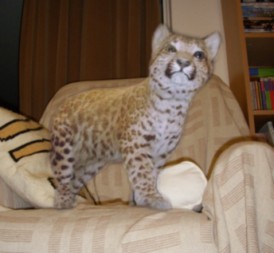
One of the first generation offspring showing the desired leopard-like markings and a body type intermediate between the domestic cat and the leopard |
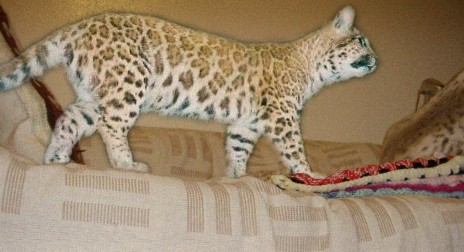
One of the first generation offspring showing the desired markings |
Offspring
Female 1 | |
| Litter 1 | 1 Male, 1 Females |
| Litter 2 |
2 Males (1 stillborn), 1 Female |
Female 2 | |
| Litter 1 | 2 Females, 1 stillbirth (gender unknown) |
| Litter 2 |
Miscarried |
| Litter 3 |
1 Male (died at 12 hours) |
Second Generation Offspring
The F1 females were mated to different shorthaired black stud cats with no recessive colour dilution gene and of moderately "Foreign" type to widen the gene pool. The Foreign type was selected as a short coat is desirable.
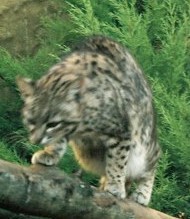
Second Generation Female Nanopard |
The 4 F1 females produced a total of 6 F2 males (plus one stillborn) and 10 F2 females, again showing a sex ratio skewed in favour of females. The F1 females proved incompetent mothers, possibly due to behavioural effects of genetic mismatches, and the kittens were fostered onto domestic cats; this again induced a second oestrus in the F1 females.
Third Generation Offspring
All F1 and F2 males were found to be sterile although they exhibited sexual behaviour. They were castrated (to eliminate sexual behaviour) and remain as companion cats with the breeding animals. Haldane's Rules indicate that the heterogamous gender (i.e. the one that produces gametes that determine gender of offspring) will be absent, non-viable or sterile. The sterile and stillborn males and those that died with hours of parturition are in accordance with this rule.
The F2 females were again mated with foreign type black cats and were able to raise their own offspring. All indications are that the F3 males will be fully fertile and these can be mated amongst themselves. In conformation they closely resemble the leopard. In size they stand approximately 20 inches at the shoulder and almost 40 inches in length (excluding tail).
Concurrently with the F2 and F3 births, 4 further F1 litters were produced, this time using a different domestic male of similar appearance and suitable genetics to further increase the gene pool. The gender ratio was again biased towards females and these will be introduced into the breeding programme.
Appearance
The F1 generation exhibited black markings on a tawny to golden brown base. The markings were intermediate in type between classic tabby and leopard rosettes giving a swirled appearance on the body with a tendency to break into spots on the legs and neck. The face and throat were spotted. The tail was rosetted to about half its length and banded with black towards the tip. The backs of the ears had white markings (ocelli).
The F2 generation were similar in appearance to the F1 generation with a greater tendency to a marbled pattern due to the decreased percentage of leopard genes. The face, throat, neck and legs retained the rosetted markings.
The F3 generation have the least spotting, but has the advantage of including fully fertile males carrying the leopard genes. Selective breeding of F3 males to F1 and F2 females will improve the markings and only those with the closest resemblance to the leopard, but with domestic temperament given consideration, will be used in the Nanopard breeding program. It is intended to back-cross the most leopard-like F3 (and later generation) males to the leopardesses to maintain and improve the Nanopard's appearance through the resulting fertile 62.5% leopard female offspring (known has "High Percent F1" offspring).
When bred among themselves, melanistic individuals are likely to occur as a result of black domestic males being used for the initial cross.
Goal
The ultimate goal is a perfect miniature of the leopard with a fully domestic temperament. A short, dense coat is desired although the recessive longhair gene from the foundation male will be difficult to eliminate. It is proposed to segregate longhaired individuals under the breed designation "Amur" The tail is to be long and carried low.
The desired colours/patterns are those of the leopard: black spots/rosettes on a pale tawny background (common leopard), melanistic with ghost markings (black panther) and albinistic with ghost markings (white panther).
Only spotted and rosetted cats may be registered as Nanopards. The marbled and clouded variants that arise due to interaction of leopard and cat genes may be developed separately, possibly with the introduction of colour dilution and long hair to mimic the Snow Leopard (the breed name "Ounce-cat" has been provisionally registered against this eventuality).
Where Can I get One?
The Nanopard waiting list is extremely long because this is the 2007 April Fool's Page from messybeast.com and such cats do not exist outside of an April Fool's joke.